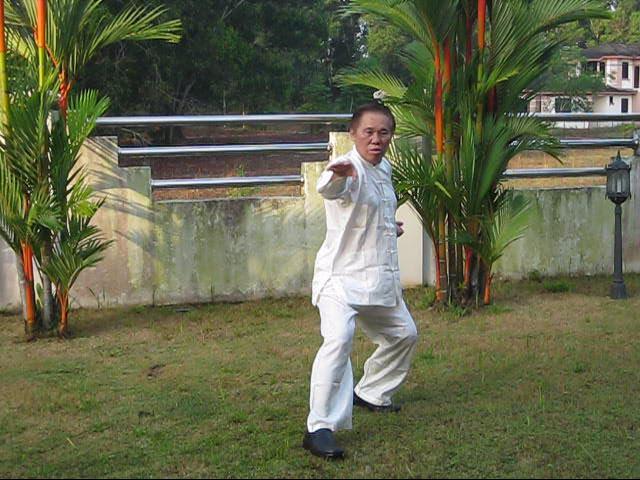SANCHIN, QIN-NA AND HOOK HAND

Wuzuquan
Question
Is Goju Sanchin similar to White Crane Sanchin? Does White Crane come from Fujian?
I am studying Shorin Ryu, Goju Ryu, and Wadokai methods.
I find that using your training methods is also very useful in Karate. -- Danny, USA
Answer
Yes, the Sanchin kata in many styles of Karate came from the San Zhan (sometimes called Sanchin) of Wuzuquan, or Five-Ancestor Kungfu, which included White Crane.
There is, however, a big difference between Sanchin practiced in Karate, and San Zhan practiced in Wuzuquzn. In Karate there is much muscular tension, whereas in Wuzuquan there is totally no muscular tension.
Yes, White Crane came from Fujian. It was a very widely practiced style of kungfu in that province.
Thank you for your kind comment.
Question
I started to look deeper into qin-na and I noticed that often the fight was over by the time an opponent hit the ground. Qin-na also offers ways of combating different holds and techniques.
If qin-na can be found in the Five Animals, is the snake much of a grabbing creature or just a wrapping creature? The snake wraps the body around branches and things, but if I further wrap a second or third time I can apply a qin-na method.
Answer
Shaolin qin-na is very sophisticated. There are three main ways of damaging an opponent -- separating tendons, dislocating joints, and gripping energy points.
All these ways are combat ending. When a Shaolin qin-na master separates his opponent's tendons, dislocates his joints or grips his energy points, even if the master lets go the opponent after he has applied these techniques, the opponent cannot fight further.
The Snake style is mainly used for wrapping, as well as going over an opponent's arm to strike him, or wriggling away to escape an opponent's grip. It is rarely used for grabbing, although a master of a snake style may use it for expedient needs.
The kungfu style that uses grabbing is Eagle Claw, and the style that uses gripping is Tiger Claw. There is a qualitative difference between grabbing in Eagle Claw and gripping in Tiger Claw.
Eagle Claw grabbing is supportive. It immobilizes an opponent so that an exponent can finish him with a decisive strike. Tiger Claw gripping by itself is combat ending. A follow-up finishing strike is not necessary.
Question
The Crane doesn't always peck. I can alter techniques to further develop options.
Answer
White Crane Kungfu and Wuzuquan do not use pecking. They are regarded as Crane styles not because of their crane beak which may be associated with pecking, but because of their general movements, especially those of their arms.
Another kungfu style that is regarded as a Crane style is Lama Kungfu from Tibet. The swinging arms of a Lama Kungfu practitioner resemble the wings of a crane. Lama Kungfu spread to China as Hap Ka Kungfu, or Kungfu of Knights.
White Crane Kungfu and Wuzuquan use grapping quite often. It is executed with the thumb as one unit and the four other fingers collectively as the other unit. An opponent's arm is grabbed between the thumb and the other four fingers.
The grabbing is quite loose, looser than in Eagle Claw, to "tame" or control an opponent while the exponent executes his decisive strike with the other hand. If we take the three main methods of holding an opponent's arm in ascending order, they will be the catch-hand of White Crane Kungfu and Wuzuquan for taming an opponent, the grabbing of Eagle Claw to immobilize an opponent, and the gripping of Tiger Claw to stop the energy flow of an opponent.
The crane beak, which is formed by holding the five fingers together, is found in Southern Shaolin. It is widely mistaken to be a hand-form to peck or poke at an opponent's vital point, like the eye or an energy point. No, it isn't. For this function, the finger of the Praying Mantis hook-hand, the fingers of a snake-palm or the knuckle of a phoenix-eye fist is more effective.
The crane beak has very specialized functions. It is used only at three places -- the eye, the throat and the groin. It is implemented firstly not with the fingers closed together, but with the fingers open like the open mouth of a crane beak as it aims at its target, grip the target with the fingers close, then pull out an eye-ball, Adam's apple or a testicle. It is a very cruel technique not suitable in today's world.
The five fingers closed together like a crane beak is also used in Northern Shaolin, and is called a hook-hand, but it is different from the Praying Mantis hook hand. It is used to hook an opponent's leg when he kicks.
You can modify your crane beak for grabbing or other options, but it will be more cost-effective if you use the appropriate hand-forms already developed by past masters for their particular purposes. For example, if you want to control an opponent, you use the catch-hand of White Crane Kungfu; if you wish to grab an opponent to immobilize him, you use Eagle Claw; if you wish to be combat ending by gripping his energy point, you use Tiger Claw.
LINKS
